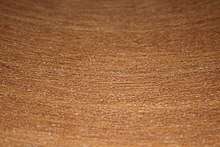Kapur (wood)
Kapur (or Kapor) is a dipterocarp hardwood from trees of the genus Dryobalanops found in lowland tropical rainforests of Malaysia, Indonesia and South-East Asia.[1] It is a durable construction tropical timber. One variety, D. aromatica, is a source of camphor.
Species
The name Kapur can refer to the following species from the Dryobalanops genus:
Deforestation
Kapur is logged from old-growth forest, often illegally. These forests have developed over the course of hundreds of years. When harvested, these trees are often between 250 and 1000 years old.[2] For a tree from the family Dipterocarpaceae, it takes approximately 100 years to reach a height of 30 meters.[3] Most of the species that are sold as Kapur, are listed on the IUCN Red List for endangered species. For example, D. fusca is critically endangered.[4]
Overexploitation has led to large scale deforestation in the tropics. The International Tropical Timber Organization is concerned with conserving the habitat of trees producing tropical timber.
According to FSC, certified tropical hardwood can counteract deforestation. Forests that are managed according to the FSC standards, become economically valuable and might therefore not be converted to farmland.[5] However, other organisations advise consumers to stay away from Kapur altogether to avoid logging of centuries-old trees.[6][7]
References
- Kapur Archived 2010-10-23 at the Wayback Machine at Queensland Department of Employment, Economic Development and Innovation
- "Rainforest Relief".
- "Rainforest Journal".
- "Search for Dryobalanops". IUCN Red List of Threatened Species. Retrieved 2020-01-10.
- "Together We Are FSC | Tropical timber, part of the solution". marketingtoolkit.fsc.org. Retrieved 2019-04-28.
- "Rainforest Relief - Kapur".
- "Wet Tropics - Good Wood Guide" (PDF).
